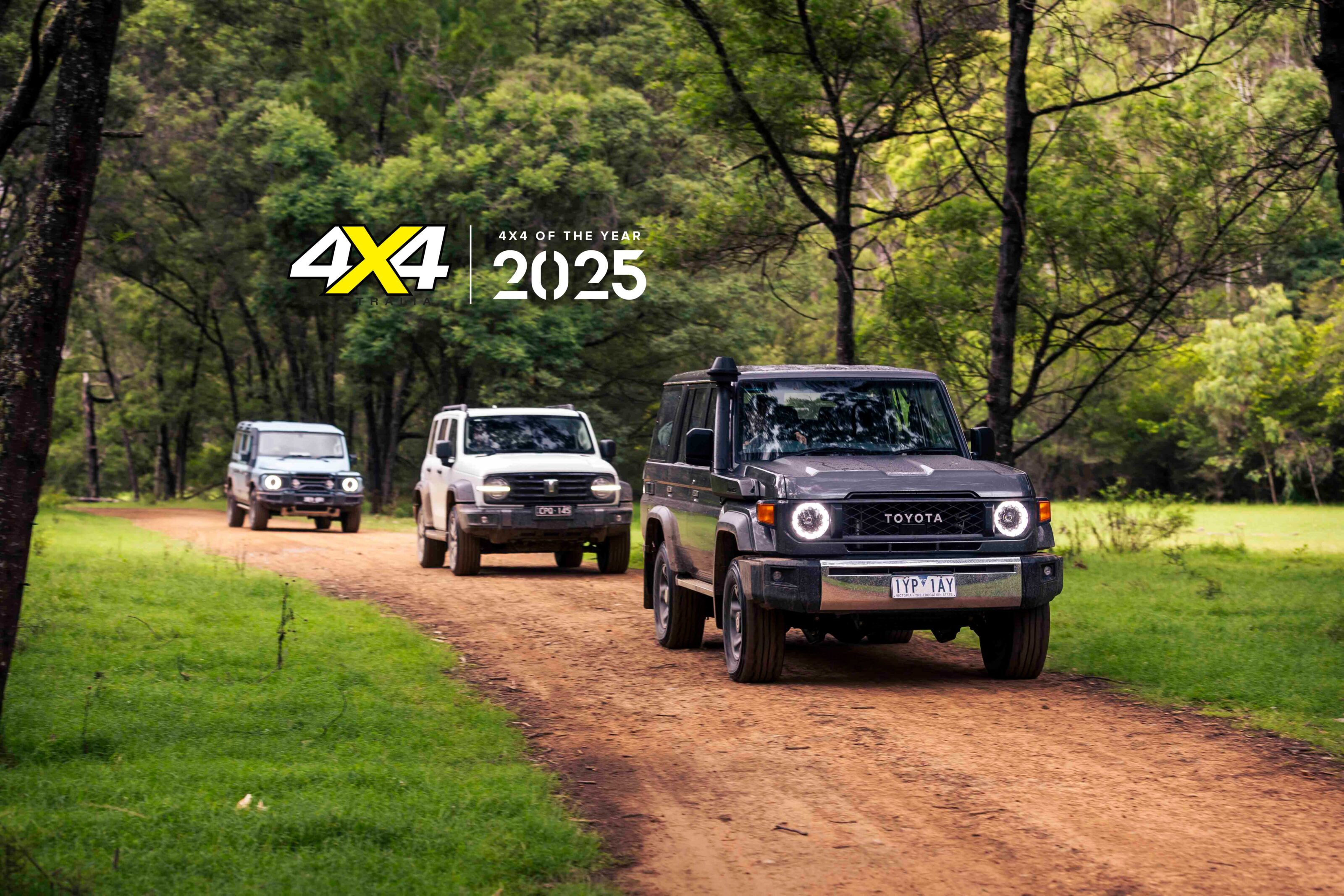Isuzu’s MU-X family wagon is in big demand, so much so that – as with most manufacturers at the moment – demand is exceeding supply. As a result, buyers are waiting up to 12 months for their new MU-X from the time they order it, and are happy to do so.
The MU-X is the second-best seller in the mid-size 4×4 wagon segment behind the always popular Toyota Prado, but ahead of great rigs like the Ford Everest, Toyota Fortuner and Mitsubishi Pajero Sport. It will be interesting to watch the effect the new V6 Everest has on this segment in the next year.

It seems many buyers opt for the higher specification of the three MU-X grades, and this is where the longest waiting times are. But do you really need the top model? Is it worth saving a few dollars by choosing the base model just to get your MU-X sooner?
Here, we’re looking at the entry-level 4×4 MU-X LS-M, which hits the market at $54,900 plus on-road costs. Keeping it bare-bones basic, we’ve bought one in basic white as the next 4X4 Australia project vehicle.
Powertrain and performance
A big part of the MU-X’s and its D-MAX sibling’s popularity, is the reputation of its venerable 3.0-litre diesel engine. In an era of decreasing engine size, three litres is considered big in this size vehicle and buyers like that.
Then there’s Isuzu’s reputation as a long-time builder of reliable diesel engines for both its passenger cars and trucks, and this is certainly the case with the 4JJ engine used in the MU-X and D-MAX.
Despite modest outputs compared to some of its competition – Everest, Fortuner and Pajero Sport – the 140kW and 450Nm engine does a fair job of moving the 2100kg MU-X along. It’s also well-suited to hauling and Isuzu rates the MU-X as being able to tow 3500kg, a feat not all of those competitors can brag about.

The Isuzu reminds you of its truck heritage every time you fire up the engine and put your foot down on the highway. It’s a relatively vocal engine by modern standards, and we find ourselves turning up the radio volume higher when in this car than we might normally do.
The four-cylinder engine is backed by a six-speed automatic transmission and there’s no manual gearbox offered in the MU-X. The Aisin-manufactured transmission is a gem and works well with the engine to get the job done.
It is a bit aggressive on its downshifts when you get off the throttle, which can be annoying at times, but rewarding if and when you are punting the MU-X along with a bit of spirit. That said, the MU-X is no sports car, it’s a high riding, four-wheel drive, seven-seat family wagon.
On-road ride and handling
Based on a platform derived from the one that underpins the D-MAX ute, the MU-X’s five-door wagon body rides high on a separate chassis with a live rear axle and IFS; both ends employing coil springs in their suspension.
It’s a package that manages the balance between load-lugging workhorse, off-road tourer and family wagon very well; although, it does feel a bit underdamped at times on uneven roads. Again, this is a family wagon not a sports car, and it does what it is designed to do.
Off-road
The MU-X inherits its part-time, dual-range 4WD system from the D-MAX and is typical for this class of wagon. Selecting 4×4 is done using a dial on the console, which is not always instantaneous in its operation and can take a few seconds to click it. This car was brand-new when driven for this test, so hopefully the transfer case operation will loosen up a bit with some more use.
The suspension gives moderate wheel articulation when the going gets more difficult and the electronic traction control is slow to react and not as effective as some others. The rough-terrain button does sharpen the calibration of the ETC, helping the MU-X along, but the question remains: Why do you need a rough-terrain button? Shouldn’t that calibration activate whenever you select low range and need the most traction possible? It seems like something the marketing department came up with, not the engineers.

There is a rear differential lock on all 4×4 MU-X models, but engaging it disables the ETC completely, resulting in the front wheels becoming almost redundant and unable to help with forward momentum. This system seems a generation or two old and holds the MU-X back from being as good as it could be when off-road. Hopefully, our plans for some more suitable tyres and aftermarket locking differential for the front axle will fix this.
Isuzu’s quoted wading depth of 800mm is handy to know; although, the front-facing air intake for the engine means I’d always take any water crossing with caution. Factory-fitted high-reaching breathers for the differentials help here and show that Isuzu does think about what’s needed for off-road use.
Cabin and accommodation
The MU-X fills the role of a three-row, seven-seat family wagon very well. The cabin is one of the larger ones in its class and, if you’re buying it to haul bodies in all three rows, the rear seat passengers will be happier in the MU-X than they would be in a Fortuner or Pajero Sport.
Access to the third-row seat is also good, giving the MU-X a most accommodating interior. It’s also a well-appointed cabin with features such as wireless Apple CarPlay and Android Auto, plus a full suite of safety kit all as standard.

The LS-M misses out on a few niceties like a full-size centre screen, heated front seats, leather trim and automatic climate control, but nothing we’d consider essential. The manual HVAC gets a thumbs up for its large, easy-to-use dials to control the heat and fan speed, but it’s then let down by the feel and function of the dials that feel cheap and clunky in their operation. Some of the other interior trims are made of similar cheap-feeling plastics that let the cabin down.
Fiddly, little slow-acting buttons in lieu of dials for the audio system are another negative, while the home screen of the audio system looks unfinished, until you enable any apps.
Practicalities
With its spacious, well-appointed cabin, relatively economical fuel consumption, adequate on-road performance and off-road ability, the MU-X stacks up as a pretty practical rig. Add in its 3500kg towing rating and it becomes a jack-of-all-trades.
The 17-inch wheels and all-terrain tyres make it more suitable for off-tarmac venturing than the bigger rims with thinner sidewall tyres, and that 800mm wading depth is better than almost any other four-wheel drive wagon.

The range of factory Isuzu accessories includes nudge bars, alloy and steel bullbars, roof racks, an intake snorkel, and even Clearview extendable towing mirrors. The MU-X has always been reasonably well-supported by the aftermarket accessories suppliers, too; although, there’s some kit still to be developed for this latest generation of MU-X.
Like most 4×4 wagons, the MU-X is limited by payload, and being the base model the LS-M gets the best of the 4×4 models with 665kg. That’s certainly something owners need to keep in mind when planning the weight of accessories they want to fit as you could take up that payload with seven large passengers, a suitcase and tank of fuel. GVM upgrades are available from some aftermarket suspension companies to improve this situation.
Verdict
While you do miss out on a few luxuries by choosing the LS-M over one of the higher-appointed models, it doesn’t really miss out on any features you need. Sure, we’d like the bigger centre screen and heated front seats of the LS-T, or even the proximity key for unlocking, but none of these are deal breakers.
We’re more than happy to live without the annoying powered tailgate, and the simple HVAC controls are much easier to use than the fiddly little buttons on the automatic climate control-equipped models. We’d even live without the third-row seats and, as this is our car, we’ll be removing these to install better cargo storage.
More than anything, we’re happy to have the 17-inch alloy wheels of the LS-M and not the 18s or 20s found on the more expensive models, as the taller sidewalls of these tyres are more durable off sealed roads and give a smoother ride quality. They call these tyres all-terrain, but they still have a very tame-looking tread pattern.

The mechanical package of the engine, transmission and driveline are all the same across the range, so we’re not sacrificing anything there with the LS-M.
Isuzu cars, both the MU-X and the D-MAX, are not the budget options they once were, and the higher prices combined with the current long delivery times might tempt potential buyers to shop around, which would be remiss if you didn’t, no matter what you are buying.
But the Isuzus remain solid, dependable and practical 4x4s, and are now better equipped than ever with all the features you could want and plenty that you may not. It might just come down to how much you’re prepared to compromise on specification and how long you are prepared to wait for it.
2022 Isuzu MU-X LS-M specs
| Engine | In-line 4-cyl diesel |
|---|---|
| Capacity | 2999cc |
| Max Power | 140kW at 3600rpm |
| Max Torque | 450Nm at 1600 to 2600rpm |
| Gearbox | 6-speed automatic |
| Crawl Ratio | 33.33:1 |
| 4×4 System | Part-time, dual-range |
| Construction | 5-door wagon on ladder chassis |
| Front Suspension | Double wishbone, coil spring IFS |
| Rear Suspension | Multi-link coil-sprung live axle |
| Tyre/Wheel | 255/65R17 / alloys |
| Kerb Weight | 2135kg |
| GVM | 2800kg |
| Payload | 625kg |
| Towing Capacity | 3500kg |
| GCM | 5900kg |
| Seating | 7 |
| Fuel Tank | 80L |
| Adr Fuel Claim | 8.3L/100km |
| On-Test Fuel Use | 9.1L/100km |
| Departure Angle | 26.4u00b0 |
| Approach Angle | 29.2u00b0 |
| Rampover Angle | 23.1u00b0 |
| Wading Depth | 800mm |
| Ground Clearance | 235mm |
We recommend
-
 Reviews
Reviews2022 Isuzu MU-X LS-T 4x4 review
Isuzu’s family-oriented MU-X scores only minor changes for 2022, retaining its adventure-ready credibility as a solid all-rounder
-
 News
News2022 Isuzu D-Max and MU-X prices rise
Follows previous drive-away price increase last year
-
 News
News4X4 Australia's modified D-Max up for auction
Avoid the long wait times, and snap up our ready to travel Isuzu D-Max through Grays Online – Hurry though, time is running out






